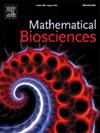An ant territory formation model with chemotaxis and alarm pheromones
IF 1.8
4区 数学
Q2 BIOLOGY
引用次数: 0
Abstract
We present and analyze a PDE model of ant territory formation, consisting of a system of reaction–advection–diffusion PDEs of chemotaxis type in two space dimensions. Following existing literature on rival ant nest interactions, two ant populations are divided into peaceful and aggressive compartments. When encountering members of the other colony, peaceful ants can turn into aggressive ants, which produce an alarm pheromone. This pheromone attracts other aggressive ants, and also turns peaceful ants into aggressive ants. It is belived that these dynamics can help explain the formation of well segregated territories, which are observed in the field. We include these dynamics into a chemotaxis-type model, which we analyze and simulate. We prove that, under a small initial mass condition, weak solutions are globally bounded, and obtain a global well-posedness result (without any mass conditions) under a mild sublinear growth assumption on the pheromone deposition term. Besides the mathematical results, we show through simulations that well-defined, non-overlapping territories emerge from the dynamics, especially in the beginning of territory formation. Our analysis therefore supports the hypothesis that these interaction dynamics are an important part of the observed territorial patterns in ants.
具有趋化性和报警信息素的蚂蚁领地形成模型
我们提出并分析了一个蚂蚁领地形成的PDE模型,该模型由两个空间上趋化型的反应-平流-扩散PDE系统组成。根据现有的关于竞争蚁巢相互作用的文献,两个蚁群被分为和平和攻击性隔间。当遇到其他蚁群的成员时,和平的蚂蚁会变成具有攻击性的蚂蚁,这会产生一种警报信息素。这种信息素会吸引其他具有攻击性的蚂蚁,也会把平和的蚂蚁变成具有攻击性的蚂蚁。据信,这些动力学可以帮助解释在野外观察到的隔离良好的区域的形成。我们将这些动态纳入一个趋化型模型,并对其进行分析和模拟。我们证明了在小初始质量条件下,弱解是全局有界的,并在信息素沉积项的温和次线性增长假设下得到了一个全局适定性结果(没有任何质量条件)。除了数学结果外,我们还通过模拟表明,定义良好的非重叠区域从动力学中出现,特别是在区域形成的开始。因此,我们的分析支持了这样一个假设,即这些相互作用的动态是观察到的蚂蚁领土模式的重要组成部分。
本文章由计算机程序翻译,如有差异,请以英文原文为准。
求助全文
约1分钟内获得全文
求助全文
来源期刊

Mathematical Biosciences
生物-生物学
CiteScore
7.50
自引率
2.30%
发文量
67
审稿时长
18 days
期刊介绍:
Mathematical Biosciences publishes work providing new concepts or new understanding of biological systems using mathematical models, or methodological articles likely to find application to multiple biological systems. Papers are expected to present a major research finding of broad significance for the biological sciences, or mathematical biology. Mathematical Biosciences welcomes original research articles, letters, reviews and perspectives.
 求助内容:
求助内容: 应助结果提醒方式:
应助结果提醒方式:


